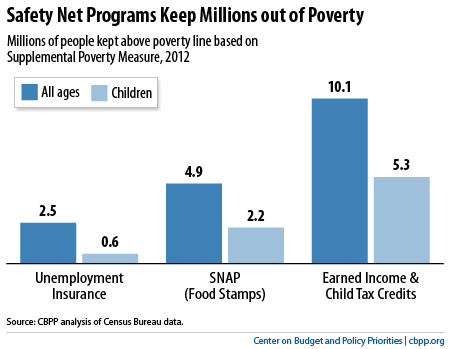BEYOND THE NUMBERS
The safety net, which is rooted in President Johnson’s War on Poverty and later expanded, helps millions of people make ends meet and access affordable health care, as we show in the third installment of our new chart book.
Today’s safety net both keeps tens of millions of people above the poverty line and has positive longer-term impacts on children, including improved educational and other outcomes, Census data and new research show.
The safety net kept 41 million people out of poverty in 2012 — including 9 million children — under the federal government’s Supplemental Poverty Measure (SPM). Unlike the official poverty measure, the SPM: 1) counts rather than ignores non-cash benefits, tax credits, and income and payroll taxes paid; 2) takes certain expenses such as child care into account when considering the income that a family has available to buy basics such as food, clothing, and shelter; and 3) accounts for geographic differences in the cost of living.
CBPP analysis of federal Census data show that the SPM poverty rate would be 29 percent if no government assistance were taken into account. But the poverty rate falls to 16 percent when such benefits are counted. The safety net reduces poverty among people of all ages, including children.
We take a closer look at the positive effects of several safety net programs in the chart book (see chart):
Together, the Earned Income Tax Credit (EITC) and the Child Tax Credit kept 10.1 million people — including 5.3 million children — out of poverty in 2012. Unemployment benefits also reduce poverty significantly, especially when unemployment is high: they kept 2.5 million people (including 600,000 children) out of poverty in 2012. And SNAP (formerly food stamps) kept 4.9 million people — including 2.2 million children — out of poverty in 2012.

Social Security was particularly effective, lifting 26.6 million people out of poverty in 2012, using the SPM. This includes 17 million seniors plus many younger people, including more than 1 million children. Without their Social Security income, 55 percent of seniors would have been poor in 2012, a Census Bureau report shows; with Social Security, their poverty rate under the SPM is 15 percent.
We’ll feature our research on other aspects of the safety net in future posts.
Click here for the chart book.
